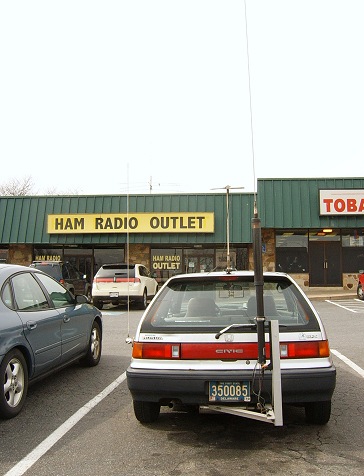
The words said by a burly lumberjack of a man as he shakes my hand. In middle school I took a few courses in the evenings with quite similar looking men both teaching and attending, not a single person there within 20 years of my own age. The courses were preperation for the amateur radio operators exam. Attending the courses ended short after a rash of rebellious boyhood behavior on my part and the subsequent groundings for eternity.
A few weekends ago it struck me that I've been working with RF for three years now professionally and I know all the respective lingo. dB's and MHz, ohms and Watts fit me like a $10 Snuggie. One thing that helped me realize this was seeing some of Diana Eng's excellent posts on Make Blog.
So the first stop the was the American Radio Relay League. I found out that there are now three levels of Amateur Radio Licenses. Technician, General and Extra. I found out when and where local exams were being held with the help of the ARRL Exam Session Search.
There are a few different avenues you can take when studying for the exams. There are books published by the ARRL in both full textbook style form and also books with just the questions and answers to the exams. There are many places online where you can practice the test on a web page which will score your test and tell you if you've passed or failed along with the right answers to the questions. The best way I found to study was by listening to the Ham Radio Podclass. These cover all the the material through the Technician and General licences. I practiced for my exam by using some great iPhone apps by Patrick J Maloney. These were well worth the money, they are slick to use and tracked my progress while I practiced.
After about a week I went and took my Technician exam and passed. It cost me about $15 dollars and all I needed to bring was a photo ID. If you pass the first test you take you can go onto the next test for free. This is always worth a shot. I didn't pass the next test unfortunately but after some studying I went back a few weeks later and passed the General exam.
Picking some hardware to communicate with was the next task at hand. I was mainly looking to operate on the VHF/UHF bands which let you communicate locally either directly between two hams or via a repeater which lets you talk over a much wider area. I compared the merits of both mobile radios and handheld transceivers.
- Mobile radios are primarily for installing into a vehicle and need a connection to the battery and an external antenna.
- Handheld transceivers are usually rechargeable and have a "rubber duck" style antenna attached.
I am lucky enough to have a Ham Radio Outlet location close by so I was able to head up there and play with some different radios and ask questions. I decided on a handheld radio so that I could operate untethered even though I would be giving up some power output. I picked out the Yaesu VX-7R. One thing I suggest doing is visiting eHam.net where you can read tons of reviews on any kind of ham equipment you can think of. When I was narrowing down my options I liked to sort their review sections by number of reviews. This helped me see what were the go-to brands and models that have good reputations.
After a week of operating mainly in my car I started to see the benefits of an external antenna so I picked up a dualband magnet mount Diamond MR77SMA. It goes right on my roof, I run it in through the trunk and it has an SMA connector that fits my handheld. This greatly increased my range for both receive and transmit.
Really the primary article that got me started down this path was Diana's Catching satellites on ham radio. Satellites were always a big draw when I was looking at the hobby when I was younger so seeing just how accessible it was to operate this mode was really exciting. WA5VJB has put together a great walk through(pdf) on making an inexpensive yagi antenna for satellite communication. I picked up some materials for less than $20 and got started on it. I need to make some adjustments and I hope to have more information about the build posted soon.
The last thing I want to talk about is software defined radio. This is the really exciting stuff! In short you take some simple (or not so simple) RF electronics and make what is in the air readable digitally. This can be done with a sound card or fancy Analog-to-Digital converters and other digital electronics. Then your able to do all sorts of things with the data. You can decode FM signals or extract image information from weather satellites. Here is a basic kind of software defined radio that is really inexpensive and can do some powerful stuff called softrock. For something really tangible you can check out WebSDR is has links to software defined radios all over the world that are receiving real signals. The data is pumped to your web browser and you can tune around the bands in real time, adjusting the bandwidths and filters. This isn't your Daddy's shoutcast stream.